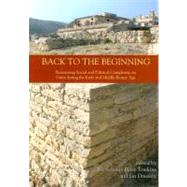Back to the Beginning : Reassessing Social and Political Complexity on Crete during the Early and Middle Bronze Age
, by Schoep, Ilse; Tomkins, Peter; Driessen, Jan- ISBN: 9781842174319 | 1842174312
- Cover: Paperback
- Copyright: 12/16/2011
The emergence of the palaces on early Bronze Age Crete is traditionally considered to be a transition from a more egalitarian society to a more complex one, with a clear hierarchical structure and elite. In John Cherry's words: "The twentieth century BC saw the appearance, in several regions of Crete, of complex monumental building (i.e. palaces) of closely similar form, the material embodiment of radically new institutional features and major changes in the organisational basis of Minoan society." The question that this publication intends to readdress 20 years after the publication of Cherry's seminal article is whether the MM IB emergence of the "First Palaces" can indeed, as argued by Cherry, be seen as a watershed in complexity and a pivotal axis of change, approaching the question by going back to the beginning of the Early Bronze Age and exploring the genesis of the architecture and of the practices incorporated in the monumental MBA structures that are traditionally known as the First Palaces. Fifteen papers present a considerable amount of new data from pivotal sites on Crete such as Knossos, Malia and Phaistos, as well as smaller sites away from any palatial centre (Mesara, Asterousia, East Crete). In the last two decades it has become increasingly clear that the Prepalatial period was considerably more complex than previously envisaged. The amount of new data and new approaches, particularly from the main palatial sites, allow us to address this question in considerably more detail than was possible 20 years ago. There is plenty of evidence at these sites for the combination of courts surrounded by architectural structures and the use of these courts as loci for the consumption of foods and liquids, as evidenced by the large amounts of tableware. In addition to this, there is evidence for long-distance exchange, specialised craft production and the production of a distinct elite culture, which were all geared towards the material expression of marked differences in society. The complexity of the Middle Bronze Age I and II periods has been overestimated as a result of retrojecting Late Bronze Age models and interpretations whereas the complexity of the Early Bronze Age was long underestimated. The papers presented in Back to the Beginning







